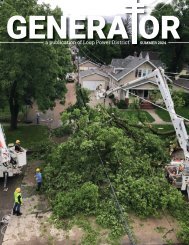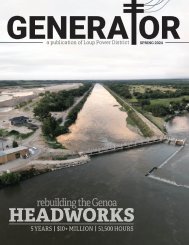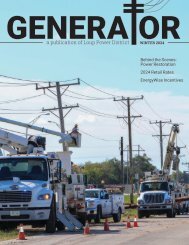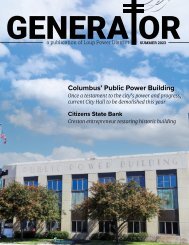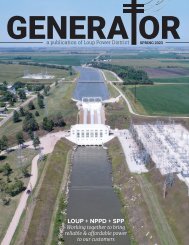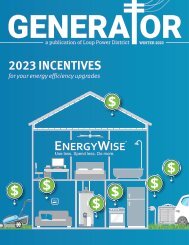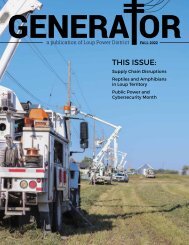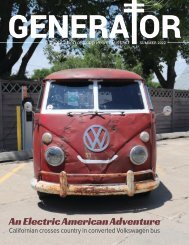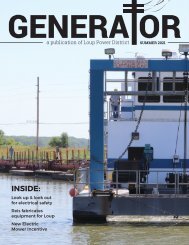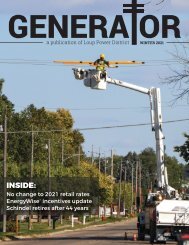Generator — Fall 2021
In this edition: Loup installs an EV charging station, the Monroe Powerhouse and Genoa get upgrades, the growing cost of natural disasters, and the Lineworkers Rodeo.
In this edition: Loup installs an EV charging station, the Monroe Powerhouse and Genoa get upgrades, the growing cost of natural disasters, and the Lineworkers Rodeo.
You also want an ePaper? Increase the reach of your titles
YUMPU automatically turns print PDFs into web optimized ePapers that Google loves.
GENERA OR<br />
a publication of Loup Power District FALL <strong>2021</strong><br />
INSIDE:<br />
Loup installs electric<br />
vehicle charging station<br />
Monroe Powerhouse<br />
Tainter Gate project<br />
Genoa system upgrade<br />
The growing cost of disasters<br />
Lineworkers Rodeo
BOARD OF DIRECTORS<br />
Ross Knott<br />
Chairman<br />
Alan Drozd<br />
First Vice Chairman<br />
Steve Heesacker<br />
Second Vice Chairman<br />
Robert Cerv<br />
Secretary<br />
Dick Tooley<br />
Treasurer<br />
Rich Aerni<br />
Jim Donoghue<br />
Mike Fleming<br />
Chris Langemeier<br />
Larry Zach<br />
EXECUTIVE STAFF<br />
Neal Suess<br />
President/CEO<br />
Walt Williams<br />
Vice President,<br />
Accounting & Finance/CFO<br />
Todd Duren<br />
Vice President,<br />
Corporate Services<br />
Korey Hobza<br />
Vice President, Engineering<br />
Dan Hellbusch<br />
Vice President, Operations<br />
The Loup <strong>Generator</strong> is<br />
published quarterly<br />
as a service for Loup<br />
employees, families,<br />
friends, and associates.<br />
For feedback, story ideas<br />
and submissions, contact:<br />
Stacy Wemhoff<br />
Communications Coordinator<br />
402-562-5711<br />
swemhoff@loup.com<br />
2 | GENERATOR<br />
PUBLIC POWER MONTH<br />
DID YOU<br />
? KNOW<br />
Nebraska is the only state in the nation<br />
served entirely by public power electric utilities.<br />
Community-owned utilities mean that<br />
Nebraskans are working for Nebraskans.<br />
Public power electric utilities<br />
are not-for-profit, meaning<br />
there’s no profit motive and<br />
no shareholder pockets to<br />
pad <strong>—</strong> simply affordable,<br />
cost-of-service electric rates<br />
for consumers.<br />
Nebraska’s electric utilities are governed<br />
by locally elected or appointed boards and<br />
councils. This means you have a voice<br />
in the decisions made by your local utility.<br />
Nebraska’s electric utilities use a diverse<br />
mix of fuel resources to generate electricity,<br />
such as wind, water, coal, nuclear, natural<br />
gas, solar and methane.<br />
Nebraska’s electric utilities pay more than<br />
$100 million<br />
to communities they serve<br />
each year in lieu of taxes.<br />
Those dollars stay local,<br />
helping to empower our<br />
hometowns.<br />
Each dollar of a public<br />
power employee’s<br />
paycheck circulates<br />
through the local<br />
economy an estimated<br />
four to five times.<br />
KEEPING<br />
LOCAL<br />
DOLLARS<br />
LOCAL.<br />
Cover: Lineman Sage Penny competes at the Lineworkers Rodeo on July 30. See more on page 12.
preSIdent’S MessAGe<br />
Public Power focuses on<br />
the customer, not the dollar<br />
October is Public Power Month, and we here at<br />
Loup Power District are extremely proud of our<br />
background in public power. As the first public<br />
power district in the State of Nebraska, Loup has<br />
been a leader in the public power movement. That<br />
is quite the accomplishment in the only state that<br />
is 100 percent public power.<br />
From Loup's beginning and development of the<br />
American Public Power Association (APPA), as<br />
well as the District’s close association with APPA,<br />
public power is all about the public. The system<br />
belongs to the people that we serve, and we strive<br />
to do our best to meet your needs.<br />
One of the newest ventures the District has delved<br />
into is electric vehicles and electric charging<br />
stations. As you have probably noticed, the District<br />
recently added an electric charging station at our<br />
General Office. This is for use by the public (for a<br />
fee), and there are two ports for use. Additional<br />
detail on this is included in this issue.<br />
The District also offers incentives to those wishing<br />
to purchase electric vehicles. These incentives are<br />
provided through NPPD’s EnergyWise program.<br />
More detail on these incentives can be found on<br />
our website, loup.com.<br />
Another way that we assist customers is through<br />
discussions involving the installation of solar<br />
panels on residences. Many customers have<br />
inquired about installing solar panels and selling<br />
excess power back to the District. There is a lot of<br />
detail and economics regarding solar panels and<br />
their installation.<br />
If you are interested, we would ask that you talk<br />
to us first <strong>—</strong> we can help you understand the<br />
economics as well as the pros and cons.<br />
The District prides itself on helping our customers<br />
in many different ways, which is what public<br />
power is all about. Celebrating Public Power<br />
Month is just another way for us to toot our own<br />
horn. We don’t often get a chance to do this, but<br />
you will hear a lot from us in October regarding our<br />
association with public power and APPA.<br />
These are just a few of the ways the District’s Board<br />
of Directors and employees have developed to<br />
assist our retail customers. If you have questions<br />
about these or any other benefit or incentive we<br />
provide, feel free to contact us and we will be<br />
happy to assist you. Being there for the customer is<br />
what makes the “public” in Public Power.<br />
NEAL SUESS<br />
President/CEO<br />
PUBLIC POWER = Local Decisions + Local Solutions + Local Jobs<br />
FALL <strong>2021</strong> | 3
LOUP INSTALLS EV CHARGING STATION<br />
Loup Power District is proud<br />
to announce the installation of<br />
an electric vehicle (EV) charging<br />
station at the District’s General<br />
Office in Columbus.<br />
There are two dedicated<br />
parking spots for EV owners who<br />
want to “fuel up” while shopping,<br />
running errands, or eating out.<br />
Todd Duren, Vice President<br />
of Corporate Services, said the<br />
charging station was partially<br />
funded with a grant from the<br />
Nebraska Environmental Trust<br />
(NET).<br />
“The EV charging station<br />
has an excellent location due<br />
to its proximity to downtown<br />
Columbus,” he said. “It’s been<br />
exciting to see EV owners from<br />
around the area using the<br />
station.”<br />
The ChargePoint charging<br />
station is networked and can be<br />
accessed through the Charge-<br />
Point app. The app helps EV<br />
owners locate nearby stations<br />
and sends notifications when the<br />
vehicles are done charging.<br />
EV owners also pay for the<br />
electricity through the app.<br />
Loup added a plug-in hybrid<br />
vehicle (PHEV), the Mitsubishi<br />
Outlander, to its fleet last year.<br />
The vehicle can go about 25<br />
miles on a full charge before<br />
switching to its internal combustion<br />
engine.<br />
The District will be purchasing<br />
an all-electric vehicle next year.<br />
This purchase is also partially<br />
funded through a grant from<br />
NET.<br />
The only regular maintenance<br />
needed for all-electric vehicles<br />
is checking the windshield wiper<br />
fluid and rotating the tires.<br />
If you do purchase an EV,<br />
be sure to let Loup or your<br />
local utility know. The service<br />
to your home is sized to meet<br />
the demands of your house<br />
as they existed when service<br />
was connected. Adding the EV<br />
charger creates a risk of overloading<br />
the wires and transformers<br />
powering your home.<br />
Want to learn more about<br />
EVs? Visit bit.ly/EV-Loup or call<br />
Greg Badstieber at 402-562-5718.<br />
EV INCENTIVES<br />
$4,500 | EV & CHARGER<br />
$4,000 incentive for the purchase<br />
or lease of a new battery electric<br />
vehicle + $500 incentive for<br />
the installation of a residential<br />
ChargePoint charging station<br />
$500 | CHARGING STATION<br />
Installation of a residential charging<br />
station<br />
PRE-WIRING<br />
In-home pre-wiring for future<br />
installation of a new EV charging<br />
station. $200 for new construction<br />
and up to $400 for existing<br />
structures<br />
4 | GENERATOR<br />
Commercial charger conduit and<br />
charger incentives are also available.
ALL ABOUT EVS<br />
HOW DO I CHARGE IT?<br />
Your electric vehicle comes with everything you<br />
need to plug it in and fuel up. The majority of<br />
electric vehicle owners charge their cars<br />
at home overnight, when electricity<br />
prices are lower. EVs can be charged<br />
on a standard 120V wall<br />
outlet, also called Level 1<br />
charging. Faster charging (about<br />
4–5 hours) can be achieved at<br />
home or the workplace with Level 2 charging.<br />
Level 3 chargers take about an hour and are<br />
typically located at public charging stations.<br />
CAN I GET WHERE<br />
I NEED TO GO?<br />
The average American’s daily commute is less<br />
than 30 miles and most electric vehicles<br />
have a range of more than 70 miles.<br />
It’s a reliable way to get from point A<br />
to point B. With growing<br />
electric vehicle charging<br />
infrastructure, you can<br />
also charge along the way. Plugin<br />
hybrids, like the Toyota Prius,<br />
can also run on battery power or<br />
gasoline.<br />
Sources: U.S. Department of Energy, PlugShare, Electrification<br />
Coalition, and Plug In America, AAA, and publicpowered.com.<br />
Graphic by American Public Power Association.<br />
e<br />
e<br />
e<br />
WHY GO ELECTRIC?<br />
Driving an EV can<br />
cost 70 percent less<br />
than a gas-powered<br />
vehicle. If you pay<br />
11¢ per kilowatt hour (kWh) for electricity<br />
and have an EV rated at 34 kWh per 100<br />
miles, the cost is about 4¢ per mile. If gas<br />
is $3 per gallon and a gas-powered<br />
vehicle gets 25 mpg, the cost<br />
is about 12¢ per mile. Electric<br />
vehicle owners are also eligible<br />
for federal and state tax credits.<br />
Electric cars are also more efficient <strong>—</strong> up<br />
to 80 percent of the charge is transferred<br />
directly to powering the car, compared to<br />
14-26 percent with gas-powered vehicles.<br />
WILL THIS CHANGE MY<br />
ELECTRIC BILL?<br />
The average electric vehicle needs 30<br />
kilowatt-hours for a 100-mile charge. At an<br />
average electricity rate of 12¢ per kWh,<br />
it can cost about $540 per year<br />
to charge your car, compared<br />
to an average of $2,000<br />
to fuel a gas-powered car.<br />
Charging during peak times<br />
could hike your electricity bill, so ask your<br />
utility what the best time is to charge.<br />
WHERE CAN I CHARGE<br />
ON THE GO?<br />
There are more than 30,000 EV<br />
“fueling” stations in the United<br />
States. Need to find a plug? Visit<br />
publicpowered.com or PlugShare.<br />
com for interactive maps.<br />
FALL <strong>2021</strong> | 5
MPH TAINTER<br />
GATE UPDATE<br />
TAINTER GATE: a radial arm floodgate used in dams and canal locks to control water;<br />
named for Wisconsin structural engineer Jeremiah Burnham Tainter.<br />
Illustration of a<br />
Tainter Gate. The<br />
original design<br />
helped send sawed<br />
lumber down river<br />
to market. Loup’s<br />
Tainter gate was<br />
constructed in the<br />
mid-1930s.<br />
The Tainter Gate at the Monroe<br />
Powerhouse serves a critical<br />
purpose as an emergency bypass<br />
that allows water to flow down the<br />
canal if the generator turbines are<br />
not available.<br />
And because the powerhouse<br />
and the gate are more than 80<br />
years old, it’s also critical to keep<br />
them in good condition.<br />
The gate was refurbished this<br />
spring and summer in a multistep<br />
process that hadn’t been<br />
completed since the mid-1990s.<br />
The gate is named for Wisconsin<br />
engineer Jeremiah Burnham<br />
Tainter.<br />
Tainter was 26 in 1862 when he<br />
began working at Knapp, Stout &<br />
Co. <strong>—</strong> the largest lumber manufacturer<br />
in the United States at<br />
the time. He was following in the<br />
footsteps of his older brother, who<br />
was a principal in the company.<br />
Tainter worked as a surveyor,<br />
and machinist. He was also a<br />
talented engineer and draftsman,<br />
and soon began maintaining dams<br />
located at the sawmill.<br />
Around 1886, the company<br />
needed a better system of dams<br />
that would allow for a rush of<br />
water to send heavy rafts of sawed<br />
lumber down the Red Cedar River<br />
to market.<br />
Tainter’s radial gate resembled<br />
a slice of pie, with the curved<br />
part facing the source of water<br />
and the top pointing toward the<br />
destination.<br />
When the gate is closed, water<br />
bears on the upstream side. When<br />
the gate is rotated, the rush of<br />
water passing under the gate helps<br />
it open and close. The rounded<br />
face, long radial arms and bearings<br />
allow it to close with less effort<br />
than a flat gate.<br />
Today, the Tainter Gate design<br />
remains largely unchanged and<br />
is used in water control dams and<br />
locks worldwide. The upper<br />
Mississippi River basin alone<br />
has 321 Tainter Gates.<br />
Source: Wikipedia, dunnhistory.org,<br />
and The Chippewa Herald.<br />
1. CATWALK CONSTRUCTION<br />
Machinist/Welder Jeremy Reis designed a catwalk<br />
for easier access to the Tainter Gate from a door<br />
on the north side of the powerhouse.<br />
L e ft : Equipment Operator Dan Hellbusch raises<br />
Reis and Equipment Operator Troy Dreifurst<br />
to the construction area.<br />
Below: The finished catwalk.<br />
6 | GENERATOR
2. STOP LOG INSTALLATION<br />
Loup employees remove the Tainter Gate from service by installing four metal stop<br />
logs on top of each other. These “logs” dewater the Tainter Gate and spillway so<br />
employees and contractors can perform maintenance.<br />
FALL <strong>2021</strong> | 7
3. SANDBLASTING TAINTER GATE<br />
Above: Lindner Painting employees sandblast the gate.<br />
Left: the top section of the radial Tainter Gate after sandblasting<br />
to bare metal.<br />
4. EPOXY PAINT<br />
Lindner Painting completed the project by applying<br />
a new coat of epoxy paint to protect the gate.<br />
Right: An engineer from Olsson, Inc., inspects the<br />
gate integrity and coating.<br />
MONROE POWERHOUSE TAINTER GATE DETAILS<br />
The MPH radial gate is 154 wide and<br />
is fully enclosed on the northwest end<br />
of the powerhouse. It is operated by an<br />
electrically powered hoist equipped with a<br />
solenoid brake.<br />
The gravity of a 9-ton counterweight<br />
facilitates lifting of the gate.<br />
If the canal flow is greater than the<br />
powerhouse capacity, the gate automatically<br />
redirects the canal flow around the<br />
turbine units through the Tainter Gate<br />
spillway.<br />
The Columbus Powerhouse does not<br />
have a bypass gate. Instead Lake Babcock<br />
and Lake North provide storage for excess<br />
flow. This gives Loup employees time to<br />
reduce flow into the canal at the Genoa<br />
Headworks if necessary.<br />
8 | GENERATOR
5. NEW SEALS<br />
The rubber seals on the sides of the<br />
Tainter Gate were replaced after<br />
painting.<br />
Top left: Columbus Plant Operator Justin<br />
Kohl lines up a new seal and retainer<br />
strap for installation.<br />
Left: Powerhouse Maintenance Tech Joe<br />
Noyd and Hydro Electrical/Mechanical<br />
Tech Matt Kathol install seals on the<br />
lower portion of the gate. They are<br />
working across from each other on both<br />
sides of the gate.<br />
Bottom: Noyd working behind the radial<br />
Tainter Gate.<br />
FALL <strong>2021</strong> | 9
The growing cost of disasters<br />
Disasters such as hurricanes, floods, fires, and tornadoes<br />
are becoming more catastrophic <strong>—</strong> and costly.<br />
The National Oceanic and Atmospheric Administration tracks climate and weather disasters<br />
that have caused an excess of $1 billion in loss and damages in the United States.<br />
Such disasters have cost<br />
$<br />
1.9 trillion<br />
Average costs per year<br />
since 1980<br />
$<br />
616.5 billion<br />
of this cost has been<br />
in the past five years<br />
at an average of<br />
$<br />
123.3<br />
billion/year<br />
The average cost,<br />
adjusted for inflation,<br />
has ballooned<br />
each decade<br />
Cost (in billions of dollars)<br />
100<br />
80<br />
60<br />
40<br />
20<br />
$<br />
18B/year<br />
$<br />
27.7B/year<br />
$<br />
52.78B/year<br />
$<br />
82.5B/year<br />
1980s<br />
1990s<br />
2000s<br />
2010s<br />
The number of billion-dollar events has also increased.<br />
Average events per year<br />
2020 had a record 22 billion-dollar events –<br />
with a total estimated cost of $95 billion.<br />
20<br />
16.2<br />
2014 was the only year in the past decade that<br />
didn’t have 10 or more billion-dollar events.<br />
Billion-dollar Events<br />
15<br />
10<br />
5<br />
2.3<br />
6.3<br />
With an average of $ 19.4B per event,<br />
hurricanes have the highest cost.<br />
All 50 states have experienced at least<br />
one billion-dollar disaster since 1980.<br />
1980-1989<br />
2000-2009<br />
2016-2020<br />
Sources:<br />
https://www.fema.gov/data-visualization/public-assistance-program-summary-obligations<br />
https://www.ncdc.noaa.gov/billions/<br />
Texas has experienced the most – with 124<br />
events representing 43% of all such disasters in<br />
the U.S.<br />
10 | GENERATOR
Utility restoration costs have increased over time, too.<br />
Factors increasing costs can include more customers (leading to more assets that can be damaged),<br />
higher cost of labor, and price increases in materials and equipment.<br />
Since 2003, the Federal<br />
Emergency Management Agency<br />
has obligated more than<br />
$<br />
25.8 billion<br />
FEMA funding to public utilities since 2003, by disaster type<br />
Area within dotted line represents share of funding allotted since 2011<br />
to public utilities through its<br />
Public Assistance program for<br />
more than 36,000 events.<br />
About 80% of these funds <strong>—</strong><br />
$20.4 billion <strong>—</strong> has been<br />
obligated since 2011 toward<br />
13,851 projects at an average<br />
cost per project of $1.47 million.<br />
Hurricane/coastal storm<br />
$<br />
21 billion<br />
Hurricane/coastal storm<br />
Severe storm<br />
Snow/Ice storm<br />
$<br />
18.5 billion since 2011<br />
Flood<br />
Fire<br />
Typhoon<br />
Tornado<br />
$974 million<br />
Severe storm<br />
$<br />
3.2 billion<br />
$169 m<br />
$<br />
492<br />
million<br />
$463 m<br />
$<br />
474<br />
million*<br />
$105 m $129 m<br />
$<br />
144<br />
million<br />
$<br />
117<br />
million<br />
Other $ 106 million<br />
$<br />
44 million<br />
MARCH 2019 STORM<br />
A combination of river ice jams and rain on top of frozen<br />
ground caused multiple breaches of the Loup canal.<br />
The total damage is estimated at more than $ 15M<br />
FEMA reimbursement is $ 3.2M to date<br />
Repair and remediation are ONGOING<br />
2,000 cfs<br />
Amount of water Loup was diverting<br />
from the Loup River in March 2019<br />
per its federal license<br />
3,500 cfs<br />
The Loup canal was designed<br />
for this amount of water in the 1930s<br />
5,000 cfs<br />
Last reading at the Genoa Headworks<br />
before the gauge washed away<br />
100,000+ cfs<br />
Estimated Loup River flow on March 14, 2019<br />
cfs: cubic feet per second<br />
FALL <strong>2021</strong> | 11
Lineworkers<br />
<strong>2021</strong><br />
<strong>2021</strong>Rodeo<br />
1<br />
2<br />
The <strong>2021</strong> Nebraska Lineworkers Rodeo was held July 30<br />
at the Custer County Fairgrounds in Broken Bow.<br />
Local Superintendent Dominic Zoucha and Journeyman<br />
Lineman Adam Babl competed in the Journeyman Lineman<br />
Division. Apprentice Linemen Sage Penny and Andy Yrkoski<br />
competed in the Apprentice Division.<br />
Loup employees from across the District volunteered<br />
to help run the rodeo and serve as event judges.<br />
Both journeymen and apprentices competed in pole top<br />
rescue events. The rest of the events remained a mystery<br />
until competitors arrived at the rodeo.<br />
This year, the journeymen mystery events were crossarm<br />
change out and cutout change out. Mystery events for<br />
apprentices were the egg climb and obstacle course.<br />
In the egg climb, competitors climb the pole with an egg in<br />
their bag. They put the egg in their mouth at the top of the<br />
pole, circle the pole, and attempt to climb down without<br />
breaking the egg.<br />
The Lineworkers Rodeo has been an annual event since<br />
2012. Competitors are judged on their ability to perform<br />
tasks safely and quickly. The event was organized by<br />
Nebraska utilities and partners.<br />
1 & 8: Adam Babl<br />
2: Supervisor of Safety and Training Rick Prater<br />
(left) prepares to hand an egg off to a competitor in the<br />
egg climb event<br />
3: Dominic Zoucha and Adam Babl<br />
4 & 9: Andy Yrkoski<br />
5 & 6: Sage Penny<br />
7: Dominic Zoucha<br />
3<br />
4<br />
12 | GENERATOR
6<br />
5<br />
7 8 9<br />
10<br />
LOUP COMPETITORS, VOLUNTEERS,<br />
AND JUDGES (L to R) <strong>—</strong> Walt Williams, Rhonda<br />
Rogers, Rick Prater, Sage Penny, Dominic<br />
Zoucha, Adam Babl, Andy Yrkoski, Lynette June,<br />
Stacy Wemhoff, Roy Babb.<br />
FALL <strong>2021</strong> | 13
14 | GENERATOR
DOES YOUR ATTIC INSULATION MEASURE UP?<br />
On a sunny summer day, with the hot sun<br />
blasting directly on the roof, attics can get up to<br />
140°F when the inside of the house is 75°F.<br />
In the winter, cooler air enters the house in<br />
the lower areas and attempts to exit the house<br />
in the higher <strong>—</strong> and warmer <strong>—</strong> areas.<br />
A house with a poor and leaky envelope will<br />
show significant heat loss through the attic and<br />
eaves.<br />
Properly insulating your home not only<br />
reduces heating and cooling costs, but also<br />
improves comfort. It really pays to have the<br />
right amount of insulation.<br />
HOW INSULATION WORKS<br />
To understand how insulation works it<br />
helps to understand heat flow, which involves<br />
three basic mechanisms <strong>—</strong> conduction,<br />
convection, and radiation.<br />
Conduction is the way heat moves through<br />
materials, such as when a spoon placed in a<br />
hot cup of coffee conducts heat through its<br />
handle to your hand. Convection is the way<br />
heat circulates through liquids and gases. It is<br />
the reason lighter, warmer air rises, and cooler,<br />
denser air sinks in your home. Radiant heat<br />
travels in a straight line and heats anything<br />
solid in its path that absorbs energy.<br />
Most common insulation materials work by<br />
slowing conductive heat flow and <strong>—</strong> to a lesser<br />
extent <strong>—</strong>convective heat flow. Radiant barriers<br />
and reflective insulation systems work by<br />
reducing radiant heat gain. To be effective, the<br />
reflective surface must face an air space.<br />
Regardless of the mechanism, heat flows<br />
from warmer to cooler until<br />
there is no longer a<br />
temperature difference.<br />
In your home, this means<br />
that in winter, heat flows<br />
directly from all heated living spaces to adjacent<br />
unheated attics, garages, basements, and<br />
even to the outdoors.<br />
Heat flow can also move indirectly through<br />
interior ceilings, walls, and floors <strong>—</strong> wherever<br />
there is a difference in temperature. During the<br />
cooling season, heat flows from the outdoors to<br />
the interior of a house.<br />
To maintain comfort, the heat lost in the<br />
winter must be replaced by your heating<br />
system and the heat gained in the summer<br />
must be removed by your cooling system. Properly<br />
insulating your home will decrease this<br />
heat flow by providing an effective resistance to<br />
the flow of heat.<br />
R-VALUES<br />
An insulating material’s resistance to<br />
conductive heat flow is measured or rated in<br />
terms of its thermal resistance or R-value <strong>—</strong> the<br />
higher the R-value, the greater the insulating<br />
effectiveness.<br />
The R-value depends on the type of insulation,<br />
its thickness, and its density. The R-value<br />
of some insulations also depends on temperature,<br />
aging, and moisture accumulation.<br />
When calculating the R-value of a multilayered<br />
installation, add the R-values of the individual<br />
layers.<br />
Installing more insulation in your home<br />
increases the R-value and the resistance to heat<br />
flow. In general, increased insulation thickness<br />
will proportionally increase the R-value.<br />
On average, you can save up to 20 percent<br />
on your home’s heating and cooling costs or up<br />
to 10 percent on its total energy costs by adding<br />
insulation to attics, floors, and crawl spaces,<br />
and by reducing unwanted air leaks all around<br />
your house.<br />
Source: energy.gov<br />
ENERGY PROPERTY TAX CREDIT<br />
• Tax credit amount: 10%<br />
of the cost, up to $500<br />
(not including installation).<br />
• Eligible products: bulk<br />
insulation products (batts, rolls,<br />
blow-in fibers, expanding spray,<br />
and rigid boards);and air sealing<br />
products with a Manufacturers<br />
Certification Statement.<br />
• Learn more at<br />
bit.ly/ES-TaxCredits<br />
ENERGYWISE SM INCENTIVE<br />
• Incentive: 15¢ per square foot<br />
with a maximum of $300 per<br />
dwelling.<br />
• Installation of attic insulation<br />
only.<br />
• Eligibility: Residential<br />
customers with existing<br />
dwellings (no new construction)<br />
that use electricity as the<br />
primary fuel source for heating.<br />
• Existing attic insulation levels<br />
must average 6" or less.<br />
Customers must install 6" or<br />
more or an R-19.<br />
• Learn more at bit.ly/EW-Loup<br />
or call Greg Badstieber at<br />
402-562-5718.<br />
FALL <strong>2021</strong> | 15
around the district<br />
ALBION LINE WORK<br />
Summer Lineman Kyle Kemper and Lineman Connor Neal perform maintenance on a 34.5kV line east of Albion.<br />
Photos by Line Foreman Dave Meyer.<br />
BOARD OF DIRECTORS<br />
The Board of Directors resumed<br />
in-person meetings at the General<br />
Office this spring.<br />
The Board held several virtual<br />
meetings at the beginning of the<br />
Covid-19 pandemic in the spring<br />
of 2020. Then, the Directors met<br />
at the Columbus Service Center for<br />
almost a year because it had more<br />
room to ensure social distancing.<br />
Front row (L to R): Steve Heesacker,<br />
Ross Knott, Alan Drozd, and Dick<br />
Tooley.<br />
Back Row (L to R): Rich Aerni, Chris<br />
Langemeier, Mike Fleming,<br />
Jim Donoghue, Robert Cerv,<br />
and Larry Zach.<br />
16 | GENERATOR
Genoa getting system upgrade<br />
Genoa's new distribution substation is the first<br />
stage of an electrical system upgrade that will<br />
benefit the entire community.<br />
The upgrade from 4.16 kV to 12.47 kV will<br />
improve performance and reliability, reduce line<br />
loss, and accommodate load growth.<br />
Loup has upgraded all of its service area except<br />
Albion and Leigh. Those communities are next in<br />
line.<br />
Fullerton Division Superintendent Guy Imus<br />
said the new substation has three circuits and is<br />
centrally located. These features will allow Loup<br />
to better serve the town.<br />
The next step in the conversion process<br />
is replacing every distribution transformer<br />
throughout the community. This will result in brief<br />
outages for a few customers at a time over the next<br />
few months.<br />
"This will be a continuing project through next<br />
spring," Imus said. "Right now we're having trouble<br />
getting the transformers we need."<br />
The pandemic is affecting supply in the electric<br />
industry just as it is for other industries.<br />
Once the town is fully converted, the old<br />
substation north of the high school will be retired.<br />
Loup installed a 69'6" laminated pole in early August for the 34kV tap going to<br />
the new distribution substation. The pole weighed about 5,300 pounds.<br />
The new substation transformer arrived in Genoa on Sept. 8.<br />
Above: Meter Relay & Equipment Tech Justin Shanle and Lineman<br />
Sage Penny prepare to hook the transformer to the crane.<br />
Left: the crane lowers the transformer to the pad.<br />
Below: Employees position the transformer as it is lowered.<br />
FALL <strong>2021</strong> | 17
employee notes<br />
DAVE SHANNO<br />
Journeyman Lineman/Serviceman<br />
Dave Shanno joined<br />
Loup in 1996 as a<br />
Lineman/Serviceman<br />
at the Albion<br />
Retail Operation.<br />
He was promoted<br />
to Journeyman<br />
Lineman in 1997<br />
while retaining his<br />
serviceman title.<br />
His duties include<br />
handling the Albion<br />
stores work, street<br />
light maintenance, and installing and<br />
maintaining new customer services.<br />
Shanno is a graduate of Creighton High<br />
School. He earned an Associate of<br />
Applied Science Degree in Utility Line<br />
from Northeast Community College in<br />
Norfolk in 1991.<br />
He and his wife, Heidi, are the parents<br />
of two children, Cody and Darien. They<br />
have one grandson, Wyatt.<br />
NIKKI BRUNKEN<br />
Customer Service Representative<br />
Nikki Brunken joined Loup Power<br />
District as a Customer Service Representative<br />
at the Columbus General<br />
Office in 2016.<br />
As Customer Service<br />
Representative<br />
Brunken’s responsibilities<br />
include<br />
greeting customers;<br />
processing payments<br />
made by mail,<br />
dropbox, or drive-up<br />
window; setting up,<br />
transferring, or closing<br />
service; taking<br />
service calls; and<br />
preparing reports.<br />
25 YEARS<br />
5 YEARS<br />
Brunken is a graduate of Silver Creek<br />
High School. She attended Central<br />
Community College - Columbus and<br />
earned a Certificate in IT.<br />
Brunken and her husband, Rob, are<br />
the parents of two children, Taylor and<br />
Grant. They have four grandchildren:<br />
Ryan, Ramsey, Bailey and Kenzie.<br />
KOREY HOBZA<br />
Vice President of Engineering<br />
Korey Hobza joined<br />
Loup Power District<br />
as Vice President<br />
of Engineering in<br />
2020.<br />
In this role, he provides<br />
leadership for<br />
the planning, design,<br />
maintenance and<br />
construction of the<br />
electric, transmission,<br />
distribution, 1 YEAR<br />
and generation<br />
systems at Loup Power. He also has<br />
supervisory responsibility for Engineering<br />
and Meter/Maintenance personnel<br />
as well as building and structures<br />
maintenance.<br />
Hobza is a graduate of Leigh Public<br />
Schools and earned a Bachelor of Science<br />
Degree in Industrial Engineering<br />
from the University of Nebraska-Lincoln.<br />
He and his wife, Peggy, have two<br />
children: Hayden, 7, and Karleigh, 4.<br />
MATT ROSNO<br />
Headworks Mechanic<br />
Loup Power District<br />
promoted Matt<br />
Rosno to Headworks<br />
Mechanic in August.<br />
In his new role,<br />
Rosno is responsible<br />
for maintaining<br />
District vehicles and<br />
equipment at the<br />
Genoa Headworks.<br />
He also troubleshoots<br />
the mechanical<br />
components of<br />
the District’s dredge, the Pawnee II.<br />
PROMOTION<br />
Rosno is a graduate of Twin River High<br />
School. He joined Loup as a Maintenance<br />
Technician in April <strong>2021</strong>.<br />
JEREMY REIS<br />
Machinist/Welder<br />
Jeremy Reis joined<br />
Loup Power District<br />
as Machinist/Welder<br />
in 2020.<br />
His duties include<br />
fabricating parts and<br />
equipment, repairing<br />
equipment and<br />
vehicles, welding,<br />
and maintenance<br />
work.<br />
Reis is a graduate<br />
of Albion High School and studied<br />
machine tool and welding at Central<br />
Community College-Columbus. He<br />
and his wife, Bridget, live in Genoa. He<br />
has two children, Reghan and Carrah,<br />
and four stepchildren, Aspen, Allison,<br />
Tyler, and Owen.<br />
ANDY WALLIN<br />
Journeyman Lineman<br />
Andy Wallin joined<br />
Loup Power District<br />
as a Lineman for the<br />
Operations-Retail<br />
Department at the<br />
Columbus Service<br />
Center in 2011. He<br />
was promoted to<br />
Journeyman Lineman<br />
in 2014.<br />
1 Year<br />
Wallin is a member<br />
10 Years<br />
of the line crew<br />
that is responsible<br />
for the construction, operation, and<br />
maintenance of Loup’s electrical<br />
transmission and distribution system in<br />
the Columbus Division.<br />
He graduated from Newman Grove<br />
High School and earned an Associate<br />
of Applied Science Degree in Utility<br />
Line from Northeast Community<br />
College in Norfolk.<br />
ENERGY TIP: <strong>Fall</strong> is the perfect time to prep your home for the upcoming<br />
winter chill. One of the best ways you can save energy and stay comfortable is to caulk<br />
and weatherstrip areas that typically need sealing. Start by sealing around windows<br />
and doors. Seal plumbing, ducting, and areas where electrical wiring comes through<br />
walls, floors and ceilings for additional energy savings.<br />
18 | GENERATOR
strategies for slaying your<br />
ENERGY<br />
VAMPIRES<br />
Halloween is just around the corner. There could be a hidden terror<br />
lurking in your home. We’re talking about energy vampires <strong>—</strong><br />
evil ghouls that suck electrical power from your appliances when<br />
you aren’t using them, taking a big bite out of your wallet<br />
Unplug!<br />
Unplug!<br />
Unplug!<br />
Unplug devices or appliances<br />
you don’t use often and those that<br />
are easy to reach as you’re heading<br />
out the door.<br />
Coffee makers only use 1–3 watts<br />
when off, but add that to your<br />
microwave, small kitchen television,<br />
toaster oven, and other unused<br />
appliances and you could save<br />
$10-20 per year just in the kitchen!<br />
Don’t forget cell phone and tablet<br />
chargers, hair dryers,<br />
and space heaters.<br />
Use Power Strips<br />
Power strips let you toggle the power flow on and off.<br />
This means you can control the power usage of clusters<br />
of devices so that they’re not consuming electricity when<br />
you’re not at home. Using a light switch that turns power<br />
outlets on and off, if you have one, accomplishes the same end<br />
with even less effort.<br />
An advanced power strip makes it even easier by turning off<br />
idle electronics without any additional steps from you.<br />
One of the easiest places to use a power<br />
strip is your entertainment center. Older<br />
set-top cable boxes and DVRs in your living<br />
room are some of the most frightening<br />
energy vampires, as they’re less efficient<br />
than newer models. Some of these devices<br />
are constantly draining 25-45 watts of<br />
energy when off.<br />
Curb Idle Time<br />
Set your computer to sleep mode or power it down<br />
when you’re not using it. Do the same with your<br />
video game console instead of leaving it paused for<br />
a prolonged period of time.<br />
Energy vampires throughout<br />
your home could add an extra<br />
10 percent to your monthly<br />
electricity bill.<br />
Take a few minutes to<br />
find them and banish<br />
them for good!<br />
Visit EnergySaver.gov<br />
for more tricks to save<br />
energy and money.<br />
Make Smart Upgrades<br />
When it comes time to send your old electronics and<br />
appliances to the graveyard, consider replacing them<br />
with ENERGY STAR devices.<br />
They have a lower standby consumption than your<br />
average devices and use less energy all around.<br />
FALL <strong>2021</strong> | 19
2404 15th Street | PO Box 988<br />
Columbus, NE 68602-0988<br />
public power<br />
Low Rates!<br />
10.97¢<br />
Nebraska<br />
Average<br />
price per<br />
kilowatt hour<br />
12.89¢<br />
Nation<br />
best state for<br />
power Grid<br />
Reliability<br />
Source: US News & World Report<br />
100%<br />
public<br />
power<br />
Public power utilities are not-for-profit.<br />
Rates are set by<br />
locally elected<br />
Boards.<br />
Meetings<br />
are open<br />
to the<br />
public.<br />
Powering Nebraska’s communities



